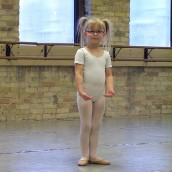Posted in Articles
The Learning Spiral

The very first thing I learned in ballet class was the plie.
I was only six, but I can remember it clearly. Trying to bend and straighten my knees while also holding in my tummy, squeezing my behind, and keep my hips over my heels was hard. When I finally got the hang of it, I was so proud.
(That girl in the photo isn’t me. I was about that age, but not that cute…)
Ballet and I drifted apart, and I didn’t grow up in the culture the way my sisters did.
So when I later learned that professional dancers start every class with plies, I was shocked. Even the New York City Ballet – world class dancers with twenty years of experience – practice them every. single. day.
But I shouldn’t have been so surprised.
Learning happens in a spiral.
We like to think of learning as a straight line.
You start at point A, work steadily until you get to point B, and then you’re done. You have mastered the topic.
But that’s not how it actually works.
Learning is a spiral process.
To master a topic, you have to revisit it over and over again. Every cycle takes you closer to mastery.
But to get there, you have to revisit where you’ve already been.
Why can’t I learn in a straight line?
Okay, I lied.
Straight-line learning does work – but only for small, simple things like memorization.
“1+1=2”
“The Saidi rhythm goes dum-tak, dum-dum-tak.”
But for larger or more complex ideas, it doesn’t work because:
1) You can’t learn it all in one go.
When you learn something new, your brain needs some time to let it percolate. It needs downtime to explore ideas, make connections, and resolve misunderstandings. If you push ahead to the next step, you’ll miss out on all that. (And probably also get frustrated, and blame yourself.)
2) You’re growing.
You come to each cycle of the spiral as a different person: you’ve had new experiences, learned new concepts, developed new skills. Even your body is different.
You may discover things in this cycle that you weren’t ready for the last time.
So how to you learn without giving up in frustration?
In our goal-oriented culture, it can be really annoying to have to revisit something over and over again.
To stay motivated, it helps to think of each cycle as a separate learning process. Here’s what I recommend:
1) Set a goal for this cycle
Decide what you’d like to accomplish this time around.
Keep it small and manageable: you’ll be revisiting this topic many many times in your dance career. You don’t need to master anything right away.
If you’re working on something complex, like learning the Jewel for the first time, the first cycle can be something as small as:
“I understand how it works, even if I can’t do it at all yet”.
2) Work on it
Work towards that small goal: ask for help, watch a video, practice, etc.
3) Celebrate!
When you reach your small goal, give yourself a pat on the back. You’ve reached the end of this cycle, and you deserve the feeling of accomplishment.
Don’t skip this step: that “small win” will help motivate you to take the next step.
4) Choose what you want next
Now you get to decide whether to start the next cycle, or work on something else for a while.
There’s no right or wrong answer. If you’re still excited about the topic, keep working on it. If something else is more attractive, you can work on that for a while.
Either way, you can feel confident that you’ve made real progress, and that the next stage is there for you whenever you’re ready.
But I want to learn it all now!
Yeah, I do too. But we can’t.
Trying to force it into a linear process just won’t work – you’ll hit a plateau. Then you’ll either give up in frustration, or you’ll think you’ve mastered it, unaware of all the rich possibilities you’ve missed.
Let’s look at an example
When I teach hip circles to my beginner students, my goal for the first spiral is for them to understand what the movement is: the hips come out from under the ribcage, and trace a circle shape, staying parallel to the floor. (vs. the tilting pelvic circle or omi.)
Some students will be able to actually do that by the end of the first lesson, and others won’t. But it doesn’t matter: as long as they understand what they’re working towards, they’ve made progress.
Then in the next spiral, they figure out how to do it. Then in the next one we polish it. Then we work on speed. Then precision. Then adding arms. Then traveling. Then musicality. Then layering. Then more musicality. And so on.
Summary
Learning is a spiral process. You can’t force your way directly to mastery, you have to circle around your goal over and over again.
To do this without giving up in frustration, define a small, manageable goal for each cycle, and acknowledge your success when you accomplish it.
Then you can start the next cycle, or put that topic on the back burner while you work on something else.
What You Can Do Right Now
Choose a skill you want to work on, and define your goal for the next cycle.
If you’re tempted to bite off more than you can chew, remember what prima ballerina Suzanne Farrell said:
“Plie is the first thing you learn and the last thing you master.”
Your Turn
Have you blamed yourself when linear learning didn’t work?
Have you experience spiral learning?
What would you like to accomplish in your next spiral?
Leave a note in the comments.
p.s. Today’s images are courtesy of daniel.baker (ballerina with cool glasses) and lostajy (spiral staircase), both via flickr.

